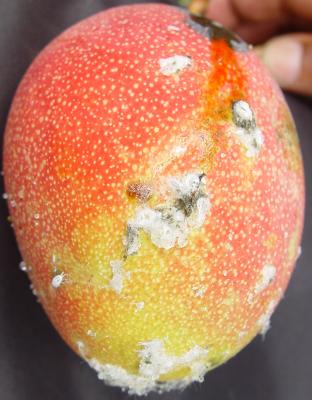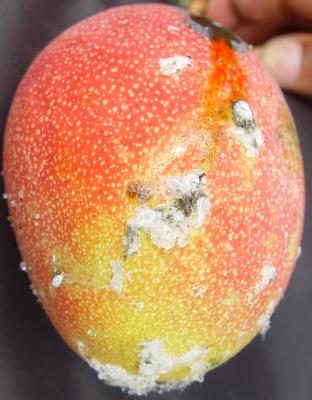

Mealybugs (Rastrococcus spp.)
Mealybugs are small, flat, soft bodied insects covered with a distinctive segmentation. Their body is covered with a white woolly secretion. They suck sap from tender leaves, petioles and fruits. Seriously attacked leaves turn yellow and eventually dry. This can lead to shedding of leaves, inflorescences, and young fruit. Mealybugs excrete honeydew on which sooty mould developed. Heavy coating with honeydew blackens the leaves, branches and fruit. This reduces photosynthesis, can cause leaf drop and affect the market value of the fruit.
A wide range of natural enemies attacks mealybugs. The most important are ladybird beetles, hover flies, lacewings, and parasitic wasps. These natural enemies usually control mealybugs. However, mealybugs can cause economic damage to mango when natural enemies are disturbed (for instance by ants feeding on honeydew produced by mealybugs or other insects) or killed by broad-spectrum pesticides, or when mealybugs are introduced to new areas, where there are no efficient natural enemies.
The latter is the case of two serious mealybug pests on mangoes in Africa: Rastrococcus invadens in West and Central Africa and Rastrococcus iceryoides in East Africa. These mealybugs, of Asian origin, were introduced into Africa, where they developed into serious pests since the natural enemies present were not able to control them. They cause shedding of leaves, inflorescences and young fruits. In addition, sooty moulds growing on honeydews excreted by the insects render the fruits unmarketable and the trees unsuitable for shading. They cause direct damage to fruits leading to 40 to 80% losses depending on locality, variety and season. Rastrococcus invadens was brought under control in West and Central Africa by two parasitic wasps (Gyranusoidea tebygi and Anagyrus mangicola) introduced from India (Neuenschwander, 2003).
Rastrococcus iceryoides is a major pest of mango in East Africa, mainly Tanzania and coastal Kenya. Although several natural enemies are known to attack this mealybug in its aboriginal home of southern Asia (Tandon and Lal, 1978; CABI, 2000), none have been introduced so far into Africa (ICIPE).
Insecticides do not generally provide adequate control of mealybugs owing to their wax coating.
- Destroy affected parts at the beginning of the infestation. Heavily infested branches may be pruned to control the pest, especially on the tender branches before flowering begins.
- Conserve natural enemies.
- Avoid excessive spraying and the use of broad-spectrum pesticides, since they may kill natural enemies.
- Control ants tending mealybugs - see also section on mealybugs on citrus datasheet.
- When necessary spray only the affected branches/trees (spot spraying). Mineral oils, neem products and soapy solutions (1 to 2%) are reported to give satisfactory control of mealybugs.
